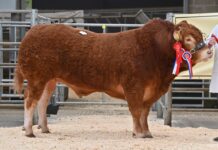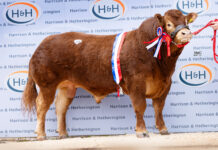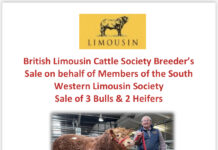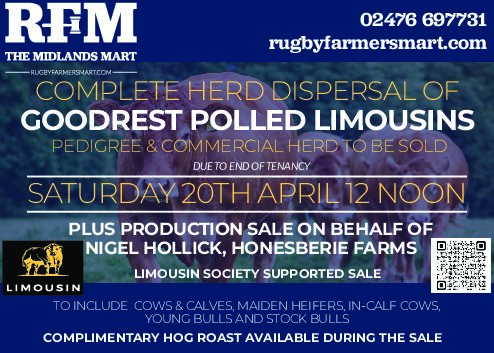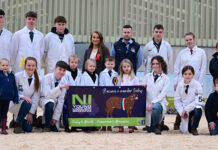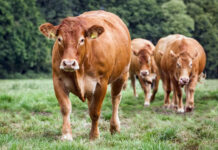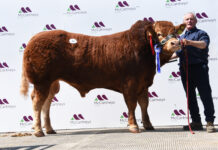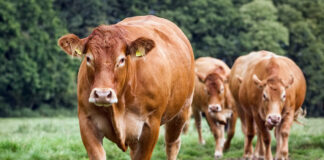Saturday 19th September: Upper Dinmore Farm will host the British Limousin Cattle Society’s 2015 Open Day. Everyone welcome.
The Dinmore herd is well known in pedigree circles, but it’s the Limousin breed’s commercial attributes that have kept it at the forefront of the cattle enterprise at Dinmore Manor Estate, Hereford, for the past 15 years.
The estate – which takes in four farms, across 2600 acres of arable, pasture and woodland – was extensively modernised by Paul Dawes (a keen advocate of the Limousin breed, with business interests in the restaurant world), having been bought by his father in 1999.
Included in the set-up are almost 1000 breeding ewes – mainly New Zealand Romneys – which are run on an easy-care system, and put to the Beltex, Texel and Charollais tups, with the lambs all sold fat. But it’s the cattle that are the mainstay of the livestock business, with 60 pedigree cows and a suckler herd of 120 mainly Limousin crosses, plus 400 store cattle which are bought in to be fattened each year (again, mainly Limousins).
Richard Bartle has managed the stock here for eight years, but his experience with Limousins stretches back three decades. As far as he’s concerned, no other breed would work as effectively within the Dinmore system.
“The fat cattle are sold to ABP on a Sainsbury’s contract and are required to be under 416kg deadweight and at least R grade – so we aim for U and E grades and as close to 400kg d/w as possible, at under 24 months. With the Limousin crosses, we can consistently achieve that – we’re getting most of them away at 17-18 months, but if we wanted to keep them longer, we could. The Limousins have an ability to be finished at any weight or age, depending on your system,” he explained.
Young pedigree bulls that don’t make the grade are fattened and sold through ABP too, reaching 400kg d/w at just 12 months old – ensuring a decent return due to being finished at such a young age.
“For us, the Limousins are easily managed and easily calved, whilst maintaining that all-important conformation,” added Richard, who says he aims to buy early maturing, finer boned bulls for the commercial herd, to ensure easy calving and a higher kill-out percentage.
“Often, the bulls that have been used on the pedigree herd are later used on the commercials too. We try to buy as best quality as possible for the commercial job, as it does make a difference to the quality of the calves, and the faster you can get the carcases away, the better the premium.”
Within the pedigree herd, the bull that has been the most influential is without doubt Wilodge Tonka, bought for 30,000gns at Carlisle in 2003.
“He made a huge difference to the females, leaving them very milky. He was easy calving and left fast growing progeny with a nice amount of bone and good temperaments,” said Richard.
Most of the current herd is based around Tonka, with the majority of the show team being by the Tonka son, Vantastic. But Richard says they are always on the lookout for something a bit different, and managed to find that two years ago with the French bull Diamant.
“He was bought on the strength of his progeny, which we saw in France. He is easy calving, with a super temperament and has brought scale into the herd. His figures have almost doubled since we brought him over because his calves have proved so fast growing.”
Diamant looks the part too, taking the Individual Interbreed title at the Royal Welsh last year – one of eight shows that the Dinmore team exhibits at annually. In 2014, they picked up seven champion and reserve tickets and won seven out of eight interbreed titles, with five different animals. This included the prestigious Burke Trophy which was won by Diamant alongside Dinmore Glorious at the Royal Three Counties. Dinmore cattle have taken the Royal Welsh championship twice in the past five years, and stood reserve three times. At the recent 2015 show the herd again performed strongly and won the Male Champion; Reserve Supreme Overall; Reserve Female; Reserve Junior Female; and further Interbreed wins as part of the Team of Five and Fitzhugh Pairs.
“We mainly stick to the same shows, but try to do one different one each year. Show cattle have to be productive too though, so we try to only show younger cattle, under four years if possible,” said Richard.
“There’s no doubt it’s a great way to promote your cattle, and this has definitely been the case with us. Probably our most successful show female has been Dinmore Elegance, and at our production sale three years ago, her full sister (Dinmore Fabulous) sold for 36,000gns – the herd’s top price to-date,” he added. The aim is to have a similar production sale every three to four years, and the team are hoping to have another next year, on-farm.
Bulls are regularly sold privately, and occasionally at Carlisle (where the 28,000gns Tonka son, Dinmore Bandit was sold in 2008), but more often at Brecon, which is closer to home.
“Being in a TB 1 area is definitely a disadvantage when selling at Carlisle, as it seems to make a difference to the buyers there. We have a clean health status though, and are very particular about animals that we buy in. We’re BVD accredited, so we vaccinate against that and Blackleg, and test for Johne’s. Also, all show females are vaccinated against IBR.”
With health status in mind, Richard says the same home-bred recipients are repeatedly used for carrying embryos, with a sweeper bull used for any recips not in calve. Generally, the best six cow families are flushed annually, with 40-60 ET calves born each year.
“Flushing is a great tool if used on the right families – it can be expensive, but it’s the best way to accelerate herd improvement.”
Around half the herd calves in the spring and the remainder in the autumn, mainly inside (for management purposes), with all calves receiving selenium and vitamin E at birth, and cows vaccinated with Rotavec six weeks before calving.
“We’ve started using a calving sensor system on the cows, which is very useful for the embryo calves, but we’ve found it works better on some cows than others, so we wouldn’t totally rely on it,” said Richard.
Without wishing to increase the pedigree numbers, Richard says they are always striving to improve the quality of the herd, although he feels the females are close to where he wants them to be – that being productive, milky, powerful cattle, with good tops and a neat tail head.
The feature text was previously published in the Summer 2015 Limousin magazine.


